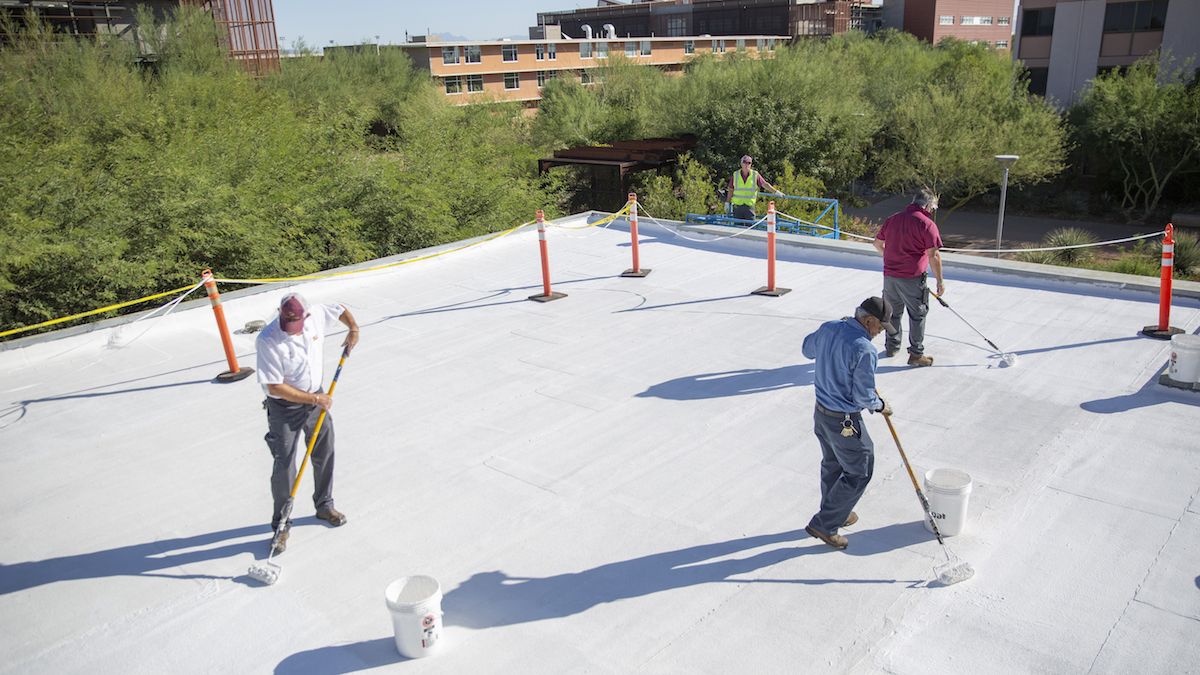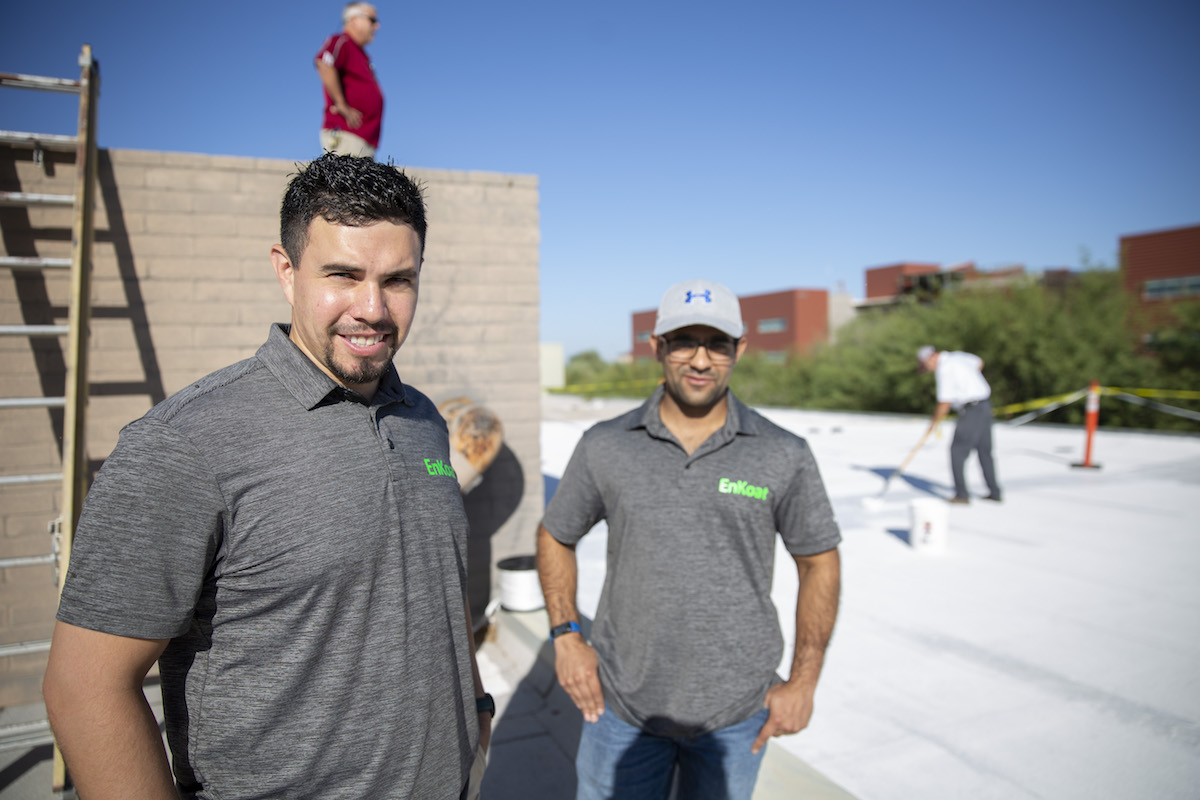
Keeping it cool: New building coatings beat the heat
Startup venture emerging from ASU engineering research could make big energy and environmental conservation impacts

Above: Arizona State University employees apply a coating to the roof of a classroom building at Arizona State University’s Polytechnic campus to conduct a test of the new material’s effectiveness. The coating developed by two recent graduates of ASU's civil, environmental and sustainable engineering doctoral program is designed to reduce the amount of energy needed maintain cool or warm temperatures inside buildings. Photographer: Connor McKee/ASU
Aashay Arora and Matthew Aguayo’s promising new technique to make buildings more energy efficient emerged from a project to produce a more resilient concrete for roads.
As Arizona State University engineering doctoral students, Arora and Aguayo had worked with Narayanan Neithalath, a professor of civil, environmental and sustainable engineering in ASU’s Ira A. Fulton Schools of Engineering, to develop a concrete pavement that would be highly resistant to cracking under thermal stress.
What they came up with was a pavement mixture that makes use of phase change materials, which can transform from solid to liquid and from liquid to solid and be used to store or release heat.
They found the physical and chemical properties of the phase change materials kept the concrete significantly cooler, and thus much less likely to crack.
That successful experiment made Neithalath wonder if using the same technology could work to keep buildings cooler.
He provided research funding to Arora and Aguayo to investigate if embedding phase change materials into paint, plaster and stucco — three of the most commonly used coatings for buildings — could maintain comfortable temperatures in the interiors of houses and other structures.
The result of that project is the startup venture EnKoat (Arora and Aguayo’s shorthand for energy saving coatings), which they and Neithalath see as a potential game changer in the energy efficiency technology industry.
Startup’s aims to produce benefits for environment
Arora and Aguayo are currently conducting more extensive testing of their coatings on the roof of the Agribusiness Center building on ASU’s Polytechnic campus.
Until now, they have been able to test coatings only in the lab and on two “mini-houses” on Aguayo’s parents’ property in Casa Grande, south of the Phoenix area.
While those tests have produced positive results, Arora says coatings applied recently to the Polytechnic campus building will provide the large-scale performance results he and Aguayo hope will attract industry attention.
More than making EnKoat a successful a business, Arora and Aguayo aspire to see their venture eventually make a positive and widespread environmental impact.
By reducing the need for electrical power to run conventional heating and air conditioning units, Enkoat’s founders say if their venture can go global it would help keep millions of metric tons of harmful carbon emissions from entering the atmosphere every year.
ASU Director of University Sustainability Practices Mick Dalrymple says there was no hesitation about using Polytechnic campus facilities for EnKoat’s testing project because the startup’s goals align with one of ASU’s key missions: to help communities solve their challenges.
“Climate change is the most critical issue our communities face,” Dalrymple says. “So, providing an environment in which young innovators can test solutions to positively impact all of our futures is not only one of our goals, but our responsibility.”

Matthew Aguayo (at left) and Aashay Arora pose atop the Agribusiness Center building at Arizona State University’s Polytechnic campus. They are the founders of EnKoat, a startup venture based on their development of coating materials that reduce energy consumption by insulating building interiors from much of the impacts of outside heat or cold. Photographer: Connor McKee/ASU
Phase change materials are driving force in the coating system
To understand the phase change process and how it is employed in EnKoat’s building coatings, think of an ice chest full of ice, Arora and Aguayo say. When external temperatures rise and start to enter the ice chest, the ice begins to melt as it absorbs the heat.
Even though the ice is melting, they explain, it is still trying to maintain the temperature inside the ice chest at 32 degrees Fahrenheit — thus activating a solid-to-liquid phase change process.
So, think of a house as the ice chest. As the temperature rises outside, the coatings begin to absorb the heat rather than letting it go into the building, and thus maintain a cooler temperature inside the house.
The coatings — which are a patent pending technology developed at ASU — can be customized to achieve maximum energy savings under varying climatic conditions.
Instead of the 32 degrees Fahrenheit being maintained in the ice chest example, the target temperatures for their coatings to maintain inside buildings are between 72 and 78 degrees — what homeowners would normally set on their homes’ thermostats.
The coatings can also incorporate different types of organic, or bio-based, phase change materials, such as agricultural feedstock. Use of such renewable resources make the EnKoat coating systems more environmentally sustainable.
The phase change materials do their work inside the coatings at a microscopic scale, while the surface texture of the coating on walls and roofs remains unchanged.
Next: Fine-tuning the business model
ASU’s Director of Energy Innovations, Gerald DaRosa, calls the system “one of the more exciting energy efficiency tools” being developed.
“What is unique compared to other phase change substances we’ve examined is that this material can be infused within construction material, such as stucco or concrete,” DaRosa says. “This could make it easier to apply the material and might also reduce the stress on the construction material caused by temperature swings.”
EnKoat now has three products — stucco for exterior walls, plaster for interior walls and paint for interior walls, exterior walls and roofs.
For maximum effectiveness, buildings need to be coated on all surfaces, Arora says, and the amount of coating necessary will vary with the environmental surroundings outside each building.
Beyond getting the results of the large-scale testing, he says, “Our target is to fine-tune our business model with the help of industry mentors and get full utility patents issued for our products. We will also seek help from local utility companies to further validate the effectiveness of our coatings and figure out rebates for early adopters.”
Challenges of moving into the marketplace
Arora and Aguayo received their doctoral degrees in civil, environmental and sustainable engineering, with a concentration in structural and materials engineering, at the end of the fall 2018 semester.
In addition to his efforts for EnKoat, Arora is now working with Neithalath as a research specialist and as a faculty associate teaching in the Del E. Webb School of Construction, which is part of the Fulton Schools. Aguayo is making a full-time commitment to EnKoat’s endeavors.
Big challenges still lie ahead for the two young entrepreneurs, says Neithalath, who teaches in the School of Sustainable Engineering and the Built Environment, one of the six Fulton Schools. On the technical side, it’s critical that EnKoat’s coatings be adapted to be effective on more kinds of building surfaces, especially brick and wood, Neithalath says.
The startup now needs to boost its business prospects by winning additional grants to fund further research and development necessary to move the coating products from the lab to the marketplace.
In addition, experienced industry advisory board members and seed investors must be found, and EnKoat must get its new systems and technologies licensed and then complete agreements with manufacturers.
The end goal, Neithalath says, “is that people should just be able to go to a store and buy the coatings and not need an engineer to tell them how to use it. It must be as simple as possible. Contractors should be given a product they can apply just like stucco, without needing to get special training.”
Winning support from investors in innovation
The success of Aashay Arora and Matthew Aguayo’s efforts over the past two years has encouraged them to seek support to further develop and scale up their Enkoat entrepreneurial enterprise.
Last spring, Aguayo’s business pitch won a sustainability award at ASU’s Change the World Showcase and Competition, while EnKoat also took the top prize at an ASU Venture Devils Demo Day, which provided $15,000 in funding from ASU’s Edson Student Entrepreneur Initiative.
EnKoat’s founders have also participated in both regional and national sessions of the National Science Foundation’s Innovation Corps training program, which prepares young scientists and engineers to commercialize technological advances being made through their university research projects.
EnKoat placed in the top 42 student-led startups of 2019 at the Rice University’s Business Plan Competition, earning the best elevator pitch and third prize overall at the TYE University Pitchfest Global Competition, which is organized by IndUS Entrepreneurs, a Silicon Valley nonprofit that supports new tech ventures.
Arora and Aguayo also won the first prize of $50,000 in the New Venture Challenge graduate course in ASU’s W. P. Carey School of Business.
To top it off, they earned a grant from ASU’s Sustainability Initiatives Revolving Fund, which invests in projects that both foster sustainability efforts and provide an economic return on investment.



































